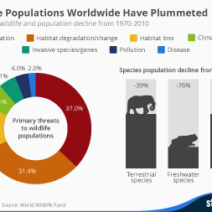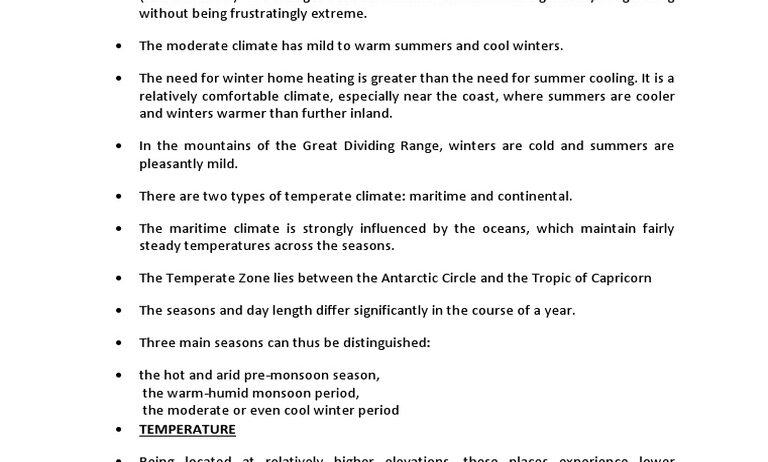Understanding a temperate climate can transport us to enchanting landscapes where the intersection of seasons creates a tapestry rich in diversity and vibrancy. Nestled comfortably between polar extremes and tropical fervor, a temperate climate is characterized by moderate temperatures and distinct seasonal changes, making it North America’s lush regions and Europe’s historical heartlands truly captivating. Often enveloped in a captivating aesthetic appeal, exploring its characteristics can unveil the subtle artistry present in nature.
What defines a temperate climate? At its essence, a temperate climate is defined by its moderate seasonal temperature variations, which provide a nurturing environment for diverse ecosystems. The phenomenon occurs primarily between the tropics and polar regions, falling between latitudes approximately 30° and 60°. The delineation of temperate zones can be attributed to their unique climatic patterns, influenced by geographical features like mountain ranges, ocean currents, and prevailing winds, which are integral to regional weather dynamics.
A cursory glance at the broad characteristics reveals an intriguing dichotomy: an interplay of warmth and coolness, beauty and chaos. This equilibrium has birthed diverse landscapes, from sweltering summers to frigid winters, all existing within a single climatic umbrella.
One of the most striking features of temperate climates is the dramatic seasonal transition, particularly in the subtropical humid and oceanic zones. Spring, bursting forth with vibrant blossoms and verdant leaf formations, draws admiration for its inherent beauty. Summer follows, enchanting with long, sun-drenched days, fostering an explosion of life as flora and fauna thrive. Autumn showcases a poignant yet splendid retreat into a riot of colors—crimson, gold, and amber leaves transforming canopies into resplendent mosaics. Winter, with its frosty visage, provides a stark contrast; the landscape transforms into a serene white blanket, muffling the vibrant life forms that characterize the warmer months. Each season offers its own aesthetic, evoking a myriad of emotions and reflections on the cyclical nature of existence.
Another captivating trait of temperate climates is their rich biodiversity. The temperate regions afford diverse habitats ranging from lush deciduous forests to sprawling grasslands and temperate rainforests. Populations of flora, from the stately oak trees standing tall to the delicate ferns carpeting the forest floor, coexist harmoniously alongside various fauna, from the sturdy deer to the elusive foxes. Dramatic shifts in temperature across seasons encourage a unique adaptation among species, resulting in a broad array of behavioral and physiological changes tailored to seasonal survival.
The temperate zone is further dissected into several climatic subtypes, each revealing its own characteristic traits:
Continental Climate
In regions exhibiting continental characteristics, denoted by hot summers and bitterly cold winters, the wide temperature spread provides an entirely different aesthetic. This climate typically graces a landlocked setting, where the distance from oceans amplifies temperature contrasts. An idyllic representation lies in the sprawling Great Plains or the expansive Russian heartland, where the landscape offers striking and wide-open views, imbued with pastoral beauty and expansive skies.
Maritime Climate
Conversely, the maritime climate thrives closer to coastlines, benefiting from the tempering influence of oceanic waters. Characterized by milder winters and moderated summers, these regions often experience enhanced rainfall, resulting in lush green scenery. Coastal cities like San Francisco and regions of the British Isles exemplify pastoral charm, with rolling hills draped in verdant shades and the rhythmic sound of crashing waves enriching the ambiance. This climate cultivates an aesthetic appeal rooted in the juxtaposition of rugged coastline and vibrant greenery.
Oceans and Their Sustainment
Nearby oceans also play a crucial role in temperate climates, particularly with respect to their warming and cooling effects. The ocean moderates temperatures, yielding milder conditions which allow for the proliferation of diverse plant and animal life. Moreover, warm ocean currents, such as the Gulf Stream, can elevate temperatures in areas far removed from the equator, fostering an environment capable of supporting temperate ecosystems. This intricate relationship between ocean currents and land highlights the interconnectedness of environmental systems, illustrating how climates are intimately woven together.
Conclusion: The Lasting Allure of Temperate Climates
A temperate climate embodies an exceptional blend of temperance and vitality. Its characteristics shape not only the natural tapestry of the landscape but also human culture and agriculture. The indescribable allure of this climate beckons explorers and nature enthusiasts, enabling a deeper appreciation for its seasons, differing artistic expressions, and the dynamic ecosystems it sustains. As the travails of climate change loom on the horizon, the need for awareness and stewardship of these temperate regions becomes ever more critical. Promoting sustainable practices and conservation efforts within these enchanting landscapes ensures that future generations too will bask in the beauty and wonder that temperate climates present.






